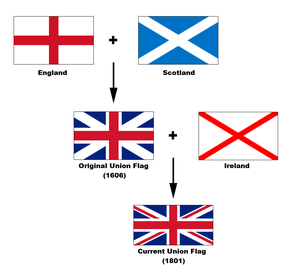Background of England
After a few months in England, I find important to focus on the background of England, such as the flag, the regions of Great Britain and how the power is divided. All right, that seems to be a too serious and studious subject but you'll see it's really interesting.
First of all the flag, do you know what do its colors reprent? Of course, everybody knows how the british flag is, but its formation has not be as simple as the french one. In fact, England and Scotland were indepedent untlil the death of Elisabeth the first. She didn't let any succesor, that why James the 6, the Scotland King took over the English trone. The fist flag gathering England and Scotland, also called the Union Jack was composed of a red cross and a white cross on blue background in 1606. But in 1707, after the Union Act between Scotland and England kingdoms, the flag became the flag of the Great Britain.
In 1801, after conflicts in Ireland between Catholics and Protestants, Northern Ireland has remaine one part of Great Britain but Southern Ireland became independant. They added to their flag the red cross (diagonal).
Why is Wales not represented in the flag of the United Kingdom? Actually, when the flag of England was created in the 13th century, Wales was considered as linked with England. These two regions were so closed that they didn't represent Wales. In fact, the first flag represented England and Wales yet.
Here is a schema in order to show you easily the evolution of the British flag.

Finally it's not such complicated, is it?! Now just a few words about Parliament. If all these regions should have formed one country, it would have be simple: one Parliament, one or two Assembly... like in the other countries. However, it's more complicated but truly interesting.
Of course, the Westminster Parliament, which is in the capital of England, London, is responsible of most of important and crucial affairs concerning foreign affairs, defens, the budget, national securities... Since 1997, Wales and Scotland have achieved more autonomy, which is called devolution. Regarding Northern Ireland, it has obtained more autonomy since 1998. In addition to the Westminster Paliament, there are the Welsh Assembly, the Scottish Parliament and the Northern Ireland Assembly.
The power of the Welsh Assemble is wicker than the power of the Scottish Parliament (just the name refers to that difference: assembly and Parliament). In both regions, the elections are fixed every 4 years, and first one was in 1999. The Welsh Assembly just have the restrict competence over welsh situation (economy, health, eduction, planning...), the Assembly cannot draft primary legislation (laws coming from the Parliament, the legislative body) but secondary legislation (legislation from the executive body).
Unlike Wales, the primary legislation takes effect. The Scottosh Parliament has also a tax varying power: the power to vary the basic rate of income tax (up to 3% of the rate of the UK).
The Parliament in Northern Ireland had been stayed from 1921 to 1972, and had been substituted by the Northern Ireland Assembly. This Assembly can legisfer in domains known as "transferred matters" by the Westminster Parliament, enumerated in the Northern Ireland Act 1998. Its power is roughly the same as the Scottish Parliament.
To conclud with this multi legislative body for the same group, let's have a look on the composition of the Wastminster Parliament. The members of Parliament (MPs) are elected by the system: "the first past the post" which means (elected to the majority) for a maximum of 5 years. There are 646 MPs in the Parliament which 36MPs for the Welsh and 72MPs for the Scott.
I hope we weren't at this brief recap about English Parliament and the Great Britain flag!
